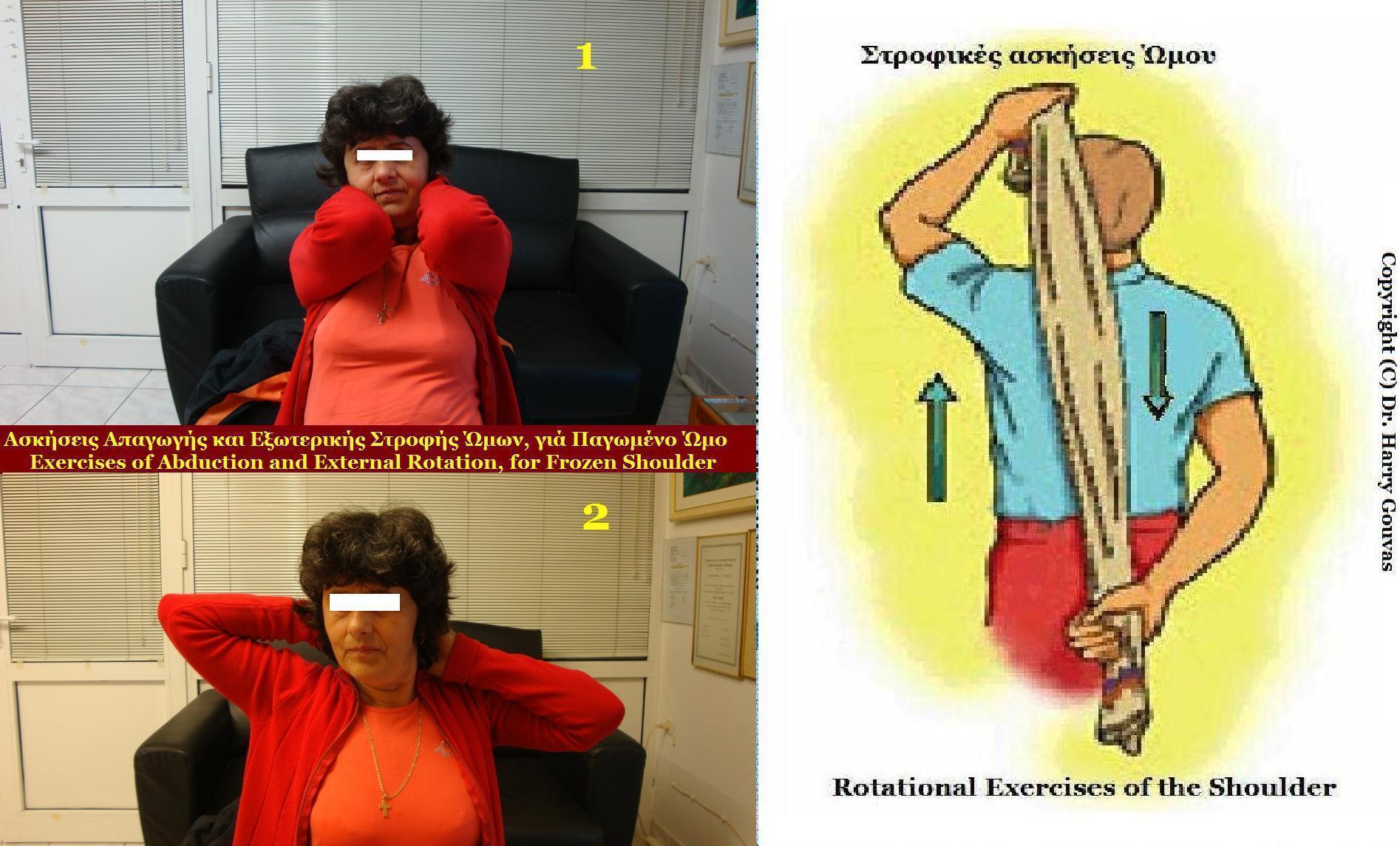Physical Address
304 North Cardinal St.
Dorchester Center, MA 02124
Physical Address
304 North Cardinal St.
Dorchester Center, MA 02124

Have you been experiencing pain and limited mobility in your shoulder? It could be a case of frozen shoulder, also known as adhesive capsulitis. As a physiotherapist with a background in working with individuals of all ages, including children and the elderly, I have seen firsthand the impact that frozen shoulder can have on daily activities. In this article, we will delve into the world of frozen shoulder physiotherapy, exploring specific exercises, treatments, and recommendations that can help you regain strength and flexibility in your shoulder. Whether you are a young athlete or an older adult, there are targeted approaches that can be tailored to your individual needs. Let’s explore the world of frozen shoulder physiotherapy together and work towards a pain-free and mobile future.
Frozen shoulder physiotherapy can be a game-changer for those dealing with this painful condition. Whether you’re experiencing stiffness, limited range of motion, or sharp shoulder pain, physiotherapy can help you regain control and movement in your shoulder joint.
Physiotherapy for frozen shoulder typically involves a range of exercises and techniques that aim to improve flexibility, reduce pain, and restore function to the affected shoulder. These exercises may include stretches, strengthening exercises, and manual therapy techniques like mobilizations and soft tissue work.
One of the main goals of frozen shoulder physiotherapy is to gradually increase the range of motion in your shoulder joint. This may involve gentle stretching exercises that target the tight and stiff muscles and connective tissues around your shoulder. Over time, these exercises can help loosen up the joint and improve your ability to move your arm freely.
In addition to exercises, your physiotherapist may also use modalities like heat, ice, ultrasound, or electrical stimulation to help manage pain and inflammation in the shoulder joint. These modalities can provide immediate relief and support your recovery process.
It’s important to note that consistency is key when it comes to frozen shoulder physiotherapy. By sticking to your exercise program and following your physiotherapist’s advice, you can gradually improve your shoulder mobility and function. Remember, patience and dedication are essential for seeing positive results in your recovery journey.
As a physiotherapist with years of experience in treating frozen shoulder, I have witnessed the transformative power of physiotherapy in helping my patients overcome their shoulder pain and stiffness. With the right guidance and support, you can effectively manage your frozen shoulder symptoms and get back to enjoying your everyday activities. Don’t let frozen shoulder hold you back – take the first step towards recovery with physiotherapy today.
Physiotherapy can be an absolute game-changer when it comes to treating a frozen shoulder. This form of therapy isn’t just your run-of-the-mill treatment option; it holds the key to unlocking the secrets of effective rehabilitation. Picture this: you’re feeling stuck and limited by your frozen shoulder, but physiotherapy swoops in like a superhero to save the day!
One of the most amazing benefits of physiotherapy for a frozen shoulder is the personalized approach it offers. Each session is tailored towards your specific needs, ensuring that you receive the utmost care and attention. This individualized treatment is designed to enhance your recovery journey, making sure that you are on the fast track to regaining mobility and function.
But wait, there’s more! Physiotherapy not only focuses on physical healing but also delves into the realm of pain management. Those alarming twinges and discomfort that accompany a frozen shoulder can be effectively addressed through specialized exercises and techniques. Say goodbye to those pesky aches and welcome a new era of relief and comfort.
As a physiotherapist consultant with a passion for helping children and elderly individuals, I have witnessed firsthand the astounding impact that physiotherapy can have on frozen shoulder patients. The joy on their faces as they regain movement and independence is truly heartwarming. It’s not merely about treating the symptoms; it’s about restoring quality of life and empowering individuals to live to their fullest potential.
Physiotherapy is like a secret weapon in the fight against frozen shoulder, offering a holistic approach that addresses not just the physical aspects but also the emotional well-being of patients. It’s a comprehensive solution that tackles the complexities of this condition head-on, navigating through the challenges with skill and expertise. So, if you’re facing the daunting task of dealing with a frozen shoulder, consider physiotherapy as your ally in the journey towards recovery. Trust me, you won’t regret taking that first step towards a brighter, pain-free future.
Whether you are recovering from a shoulder injury or looking to prevent one, incorporating is crucial for your physiotherapy routine. These exercises are designed to slowly increase range of motion, reduce stiffness, and strengthen the muscles surrounding the shoulder joint. Let’s dive into some essential exercises that can help you on your journey to recovery.
Pendulum Stretch: Swaying your arm back and forth like a pendulum can help loosen up tight shoulder muscles and improve flexibility. This gentle exercise can be done while standing or sitting, allowing your shoulder to relax and slowly increase its range of motion.
Cross Body Stretch: Reach one arm across your body towards the opposite shoulder and gently press on your elbow to deepen the stretch. This exercise helps stretch the muscles in the back of your shoulder and improve flexibility.
Shoulder Blade Squeeze: Sit or stand with good posture and squeeze your shoulder blades together as if you are trying to hold a pencil between them. This exercise helps strengthen the muscles in your upper back and improve shoulder stability.
External Rotation: Using a resistance band or light weights, perform external rotation exercises by keeping your elbow close to your side and rotating your forearm outwards. This exercise targets the rotator cuff muscles, which are essential for shoulder stability and function.
Wall Walks: Stand facing a wall and walk your fingers up the wall as high as you can comfortably reach. This exercise helps improve shoulder flexibility and mobility by stretching the muscles and tendons in your shoulder joint.
By incorporating these key exercises into your frozen shoulder recovery routine, you can gradually improve your range of motion, reduce pain and stiffness, and strengthen the muscles supporting your shoulder joint. Remember to consult with a physiotherapist or healthcare professional before starting any new exercise routine to ensure it is safe and appropriate for your individual needs.
I have personally seen great improvements in my patients’ shoulder mobility and function by consistently incorporating these exercises into their physiotherapy sessions. Remember, consistency is key when it comes to recovery, so don’t get discouraged if progress is slow – every small step counts towards your overall improvement. Let’s work together towards a healthier and stronger shoulder!
Consistency is key when it comes to physiotherapy treatment, especially for conditions like frozen shoulder. It’s not just about showing up for appointments; it’s about following through with recommended exercises and lifestyle changes. Think of it as a partnership between you and your physiotherapist in working towards your goal of improved mobility and pain relief.
Imagine your body as a garden that needs regular watering and care to flourish. Missing appointments or slacking off on exercises is like neglecting your garden – it won’t thrive. But if you stay committed and put in the work, you’ll see the fruits of your labor in the form of increased range of motion and reduced stiffness.
Consistency also helps build momentum in your treatment plan. Each session builds on the progress made in the previous one, so skipping sessions can disrupt this flow. It’s like climbing a staircase – each step brings you closer to your goal, but if you skip steps, you’ll struggle to reach the top.
One of the biggest benefits of staying consistent with your physiotherapy treatment is that it helps prevent setbacks. By sticking to the plan laid out by your physiotherapist, you’re less likely to experience flare-ups or the return of symptoms. It’s like laying a strong foundation for a house – the more solid it is, the less likely it is to crumble.
In my experience working with clients, I’ve seen firsthand the impact of consistency on their recovery journey. Those who follow their treatment plan diligently tend to see faster and more lasting results compared to those who are inconsistent. It’s like fueling a fire – the more you feed it, the stronger it burns. So, if you’re dealing with a frozen shoulder or any other musculoskeletal issue, remember: consistency is key to unlocking your body’s potential for healing and mobility.
When it comes to frozen shoulder rehabilitation, it’s important to navigate the complexities of the process with care. Many people make common mistakes that can hinder their progress and prolong their recovery. As someone who has been in the field of physiotherapy for over a decade, I have seen my fair share of these mistakes and have some tips to share to help you avoid them.
One common mistake I often see is pushing through the pain. While it’s important to challenge yourself during rehabilitation, it’s equally important to listen to your body. If you’re experiencing sharp or intense pain, it’s a sign that you may be pushing too hard. Listen to your body and don’t be afraid to take it slow. Remember, it’s a journey, not a race.
Another mistake is neglecting to do your exercises consistently. Consistency is key when it comes to rehabilitation. Missing sessions or not following through with your prescribed exercises can slow down your progress. Set a schedule and stick to it, even on days when you’re not feeling up to it. Your future self will thank you for it.
One more mistake to avoid is neglecting to communicate with your physiotherapist. Open communication is crucial for a successful rehabilitation process. If you’re experiencing any issues or have questions about your treatment plan, don’t hesitate to reach out to your healthcare provider. They are there to help guide you through your recovery journey.
Lastly, don’t fall into the trap of comparing your progress to others. Your journey is unique and may not look like anyone else’s. Focus on your own improvements and celebrate your successes, no matter how small they may seem. Remember, every step forward is a step in the right direction.
In conclusion, by avoiding these common mistakes and following these tips, you can set yourself up for a successful frozen shoulder rehabilitation journey. Remember, patience, consistency, communication, and self-care are key. Stay positive and trust the process, and you’ll be on your way to regaining full range of motion in no time. If you have any questions or need further advice, don’t hesitate to reach out. Your health and well-being are our top priorities.
When it comes to managing frozen shoulder pain and stiffness, physiotherapy can be a game-changer. It’s not just about relieving the immediate discomfort; it’s about unlocking the secrets to long-term relief and improved mobility. As a physiotherapist consultant, I’ve seen firsthand the incredible impact that targeted exercises and techniques can have on restoring function and quality of life for my patients.
One of the key strategies in physiotherapy for frozen shoulder is gentle stretching exercises. These movements help to improve flexibility in the shoulder joint and surrounding muscles, reducing stiffness and discomfort. By incorporating a series of tailored stretches into your daily routine, you can gradually increase range of motion and alleviate pain over time. It may seem daunting at first, but with consistency and dedication, you can see remarkable improvements.
Another essential component of frozen shoulder physiotherapy is strengthening exercises. Building up the muscles around the shoulder joint not only provides support and stability but also helps to prevent future injuries. By targeting specific muscle groups through a variety of exercises, you can improve overall shoulder function and reduce the risk of recurrent pain. With guidance from a skilled physiotherapist, you can create a personalized exercise plan that addresses your unique needs and goals.
In addition to stretching and strengthening exercises, manual therapy techniques can play a crucial role in managing frozen shoulder symptoms. From joint mobilization to soft tissue massage, hands-on therapy can help to release tension, improve circulation, and promote healing in the affected area. By combining these techniques with targeted exercises, you can maximize your treatment outcomes and accelerate your recovery process.
As you navigate the complexities of frozen shoulder pain and stiffness, remember that physiotherapy offers a holistic approach to healing. It’s not just about addressing the symptoms; it’s about empowering you to take control of your health and well-being. By working closely with a knowledgeable physiotherapist, you can develop a comprehensive treatment plan that addresses your unique needs and preferences. With dedication and perseverance, you can overcome frozen shoulder and get back to living your life to the fullest.
Physiotherapy is a powerful tool on its own, but when combined with other treatment modalities, it can provide even greater benefits for conditions like frozen shoulder. By incorporating various techniques and approaches, we can create a comprehensive treatment plan that targets the root cause of the issue and helps alleviate pain and improve mobility.
One of the most common combinations is using physiotherapy alongside medication to manage pain and inflammation. This two-pronged approach can provide immediate relief while also addressing the underlying musculoskeletal issues through targeted exercises and manual therapy. By working together, these modalities can help speed up the healing process and improve overall outcomes.
Another effective combination is pairing physiotherapy with modalities like hot and cold therapy or electrical stimulation. These additional treatments can help reduce muscle spasms, increase blood flow, and promote tissue healing. When used in conjunction with physiotherapy exercises, they can enhance the effectiveness of the overall treatment plan and accelerate recovery.
In some cases, combining physiotherapy with modalities like acupuncture or massage therapy can provide a holistic approach to healing. These complementary treatments can help address both the physical and emotional aspects of the condition, promoting relaxation, reducing stress, and improving overall well-being. By taking a comprehensive approach to care, patients can experience a more well-rounded and effective treatment plan.
My personal experience working with patients experiencing frozen shoulder has shown me the value of . By customizing each treatment plan to meet the individual needs of the patient, we can provide a tailored approach that maximizes results. Whether it’s incorporating medication, manual therapy, or complementary therapies, the goal is always the same: to help patients achieve optimal recovery and regain function.
In conclusion, offers a multifaceted approach to treating conditions like frozen shoulder. By leveraging the benefits of different therapies and techniques, we can create a more comprehensive and effective treatment plan for patients. If you’re dealing with a frozen shoulder or any other musculoskeletal issue, consider exploring the benefits of combining physiotherapy with other modalities to unlock the full potential of your recovery journey.
Q: What is frozen shoulder?
A: Frozen shoulder, also known as adhesive capsulitis, is a condition characterized by pain and stiffness in the shoulder joint, making it difficult to move the arm.
Q: How does frozen shoulder physiotherapy help?
A: Physiotherapy for frozen shoulder focuses on improving range of motion and reducing pain through targeted exercises and manual therapy techniques.
Q: What are some common physiotherapy exercises for frozen shoulder?
A: Some common exercises include pendulum stretches, shoulder circles, wall crawls, and shoulder blade squeezes to help improve flexibility and strength in the shoulder joint.
Q: How long does it take to see improvement with frozen shoulder physiotherapy?
A: The timeframe for seeing improvement can vary for each individual, but with consistent effort and adherence to the prescribed exercises, most patients can expect to see improvements within a few weeks to months.
Q: Are there any potential risks or side effects with frozen shoulder physiotherapy?
A: As with any form of physical therapy, there is a risk of aggravating the condition if exercises are done incorrectly or too aggressively. It is important to consult with a trained physiotherapist and follow their guidance closely to minimize any potential risks.
Q: Can I do physiotherapy for frozen shoulder at home?
A: While it is possible to do some exercises at home, it is recommended to work with a qualified physiotherapist to ensure that you are performing the exercises correctly and to receive personalized guidance based on your specific condition.
In conclusion, frozen shoulder can be a painful and debilitating condition, but with the right physiotherapy treatment, patients can see significant improvement in their range of motion and pain levels. It’s important to work closely with a physiotherapist to develop a personalized treatment plan that suits your individual needs. Remember, consistency is key when it comes to regaining full function of your shoulder. So don’t be afraid to put in the work and stay committed to your physiotherapy exercises. With patience and perseverance, you can overcome frozen shoulder and get back to enjoying a full and active lifestyle.